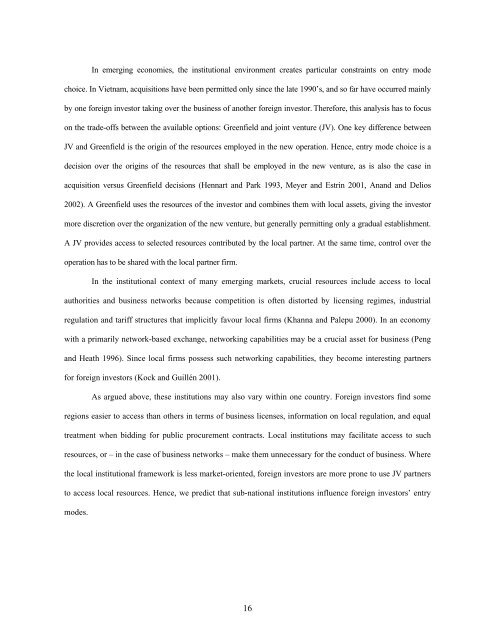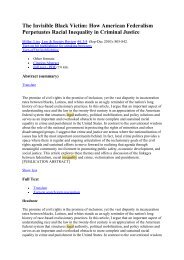Foreign Investment Strategies and Sub-national ... - E-Journal
Foreign Investment Strategies and Sub-national ... - E-Journal
Foreign Investment Strategies and Sub-national ... - E-Journal
Create successful ePaper yourself
Turn your PDF publications into a flip-book with our unique Google optimized e-Paper software.
In emerging economies, the institutional environment creates particular constraints on entry mode<br />
choice. In Vietnam, acquisitions have been permitted only since the late 1990’s, <strong>and</strong> so far have occurred mainly<br />
by one foreign investor taking over the business of another foreign investor. Therefore, this analysis has to focus<br />
on the trade-offs between the available options: Greenfield <strong>and</strong> joint venture (JV). One key difference between<br />
JV <strong>and</strong> Greenfield is the origin of the resources employed in the new operation. Hence, entry mode choice is a<br />
decision over the origins of the resources that shall be employed in the new venture, as is also the case in<br />
acquisition versus Greenfield decisions (Hennart <strong>and</strong> Park 1993, Meyer <strong>and</strong> Estrin 2001, An<strong>and</strong> <strong>and</strong> Delios<br />
2002). A Greenfield uses the resources of the investor <strong>and</strong> combines them with local assets, giving the investor<br />
more discretion over the organization of the new venture, but generally permitting only a gradual establishment.<br />
A JV provides access to selected resources contributed by the local partner. At the same time, control over the<br />
operation has to be shared with the local partner firm.<br />
In the institutional context of many emerging markets, crucial resources include access to local<br />
authorities <strong>and</strong> business networks because competition is often distorted by licensing regimes, industrial<br />
regulation <strong>and</strong> tariff structures that implicitly favour local firms (Khanna <strong>and</strong> Palepu 2000). In an economy<br />
with a primarily network-based exchange, networking capabilities may be a crucial asset for business (Peng<br />
<strong>and</strong> Heath 1996). Since local firms possess such networking capabilities, they become interesting partners<br />
for foreign investors (Kock <strong>and</strong> Guillén 2001).<br />
As argued above, these institutions may also vary within one country. <strong>Foreign</strong> investors find some<br />
regions easier to access than others in terms of business licenses, information on local regulation, <strong>and</strong> equal<br />
treatment when bidding for public procurement contracts. Local institutions may facilitate access to such<br />
resources, or – in the case of business networks – make them unnecessary for the conduct of business. Where<br />
the local institutional framework is less market-oriented, foreign investors are more prone to use JV partners<br />
to access local resources. Hence, we predict that sub-<strong>national</strong> institutions influence foreign investors’ entry<br />
modes.<br />
16














